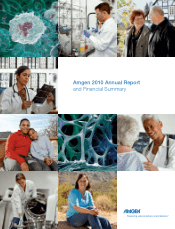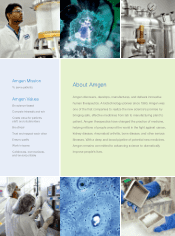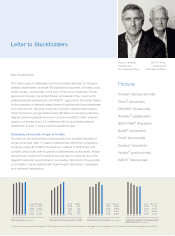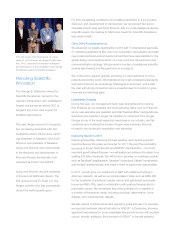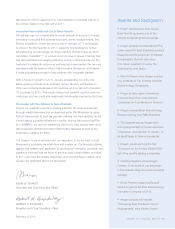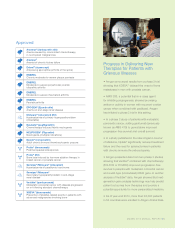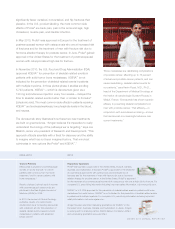Amgen 2010 Annual Report Download - page 8
Download and view the complete annual report
Please find page 8 of the 2010 Amgen annual report below. You can navigate through the pages in the report by either clicking on the pages listed below, or by using the keyword search tool below to find specific information within the annual report.
1995 1999-20021997-1998
Initial Breakthrough
OPG is disclosed in Amgen
patent fi lings as a key regulator
of bone density.
Early Clinical Research
RANK Ligand inhibitors are tested
in human volunteers. First dose of
denosumab is given on June 30, 2001.
Discovery of RANK-RANK Ligand-OPG Pathway
RANK and RANK Ligand and their roles in promoting osteoclast
formation and survival are identifi ed.1, 2, 3 OPG’s role as a decoy
receptor for RANK Ligand is elucidated.3
The Science Behind Amgen’s Two Newest Therapies—
Prolia® (denosumab) and XGEVA™ (denosumab)
References: 1. Simonet WS et al. Cell. 1997;89:309-319. 2. Anderson DM et al. Nature. 1997;390(6656):175-179. 3. Lacey DL et al. Cell. 1998;93:165-176. 4. McClung MR et al. N Engl
J Med. 2006;354:821-831. 5. Ellis GK et al. J Clin Oncol. 2008;26:4875-4882. 6. Lipton A et al. J Clin Oncol. 2007;25:4431-4437. 7. Cummings SR et al. N Engl J Med. 2009;361:756-765.
8. Stopeck AT et al. J Clin Oncol. 2010;28:5132-5139.
In the early 1990s, Amgen launched a research initiative, the
Genome Project, to discover the function of newly identifi ed
proteins. Early in that effort, scientist Dave Hill noticed
something interesting on the x-ray of a mouse designed to
express novel genes. “I remember thinking, ‘Wow! Something
is different about the bones in this x-ray,’” he says.
What Hill saw was that the bones were denser. Amgen called
the protein responsible for this effect osteoprotegerin (OPG).
Its discovery solved certain mysteries in bone biology:
Researchers knew that cells called osteoblasts build bone and
that osteoclasts remove bone in an ongoing cycle called bone
remodeling. The mysteries lay in how the process is regulated
and why bone-destroying osteoclasts become dominant in
diseases like osteoporosis and metastatic bone cancer. OPG
functioned as an off-switch for osteoclasts, but how did it work?
Scientists at Immunex (now Amgen) identifi
ed two proteins
that interact with one another, RANK and RANK Ligand.
Through a series of studies utilizing OPG as a discovery
tool, it was determined that RANK and RANK Ligand work
together to stimulate osteoclast formation, function, and
survival, thereby removing bone. Amgen determined that
the protein OPG interferes with the lock and key mechanism
that exists between RANK Ligand and RANK. The result
was that bone removal is inhibited.
RANK Ligand also plays a destructive role in solid-tumor
cancers that metastasized or spread to bone. Bone
metastasis occurs in up to 75 percent of patients with
advanced breast, lung, and prostate cancers. Tumor
cells stimulate production of RANK Ligand, which triggers
the osteoclast activity that resorbs bone and releases
the growth factors that enlarge tumors. The metastasis
weakens the bone and leads to skeletal-related events
(SREs), specifi cally fractures and spinal cord compression
that can necessitate surgery and radiation to mitigate
bone pain and damage.
One Step Back, Two Steps Forward
The fi rst effort to translate the science into a medicine fell
short: A therapeutic version of OPG strengthened bone,
but in one human volunteer it also provoked an immune
response. Amgen mitigated that risk with a backup antibody
to inhibit RANK Ligand. It was called denosumab.
Denosumab showed great promise in early trials. Amgen
developed denosumab into two therapies, Prolia® and
XGEVA™
, given at different doses and dosing intervals and
to different patient populations. A pivotal phase 3 study in
7,808 postmenopausal patients with osteoporosis showed
that Prolia®—which is denosumab given as a 60 mg
subcutaneous injection every six months—resulted in

